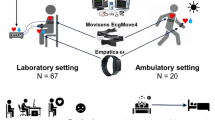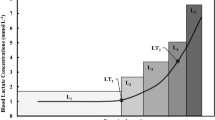Abstract
Ambulatory recording of physiological data will provide us deep insight into the physical condition of patients and athletes, and assessing treatment effects and training performances. This study presents a miniature wearable cardiopulmonary monitoring system called “Smart Chest Strap,” which consists of an elastic band worn around the user’s chest with integrated sensors, a physiological signals acquisition unit, and a mobile phone. The physiological signals including electrocardiogram, respiratory inductance plethysmograph, and accelerations (ACC) are sampled, digitalized, stored, and simultaneously transmitted to a mobile phone via Bluetooth. A medical validation test with participants performing discontinuous incremental treadmill (0–12 km/h) exercise was conducted. The results indicate nearly perfect correlations (0.999, 0.996, 0.994), small mean bias (0.60 BPM, 0.51 BPM, 0.05 g), and narrow limits of agreement (±2.90 BPM, ±1.81 BPM, ±0.09 g) for heart rate (HR), breathing rate (BR), and ACC represented as vector magnitude units (VMUs). There is a general trend of decrease in accuracy, precision, and correlation for HR, BR, and VMU as velocity increases, but these validity statistics are all within acceptable error limits and clinically accepted. The findings demonstrate that the Smart Chest Strap is valid and will have wider applications in healthcare, sports, and scientific research areas.







Similar content being viewed by others
References
Arzeno NM, Deng ZD, Poon CS (2008) Analysis of first-derivative based QRS detection algorithms. IEEE Trans Biomed Eng 55:478–484. doi:10.1109/TBME.2007.912658
Bland JM, Altman DG (1995) Calculating correlation coefficients with repeated observations: part 1—correlation within subjects. BMJ 310:446. doi:10.1136/bmj.310.6977.446
Bland JM, Altman DG (1999) Measuring agreement in method comparison studies. Stat Methods Med Res 8:135–160. doi:10.1177/096228029900800204
Bland JM, Altman DG (2003) Applying the right statistics: analyses of measurement studies. Ultrasound Obstet Gynecol 22:85–93. doi:10.1002/uog.122
Chawla NV, Davis DA (2013) Bringing big data to personalized healthcare: a patient-centered framework. J Gen Intern Med 28(Suppl 3):S660–S665. doi:10.1007/s11606-013-2455-8
Farina D, Cianca E, Marchetti N, Frattasi S (2012) Special issue: wearable computing and communication for e-health. Med Biol Eng Comput 50:1117–1118. doi:10.1007/s11517-012-0976-7
Goodrich S, Orr WC (2009) An investigation of the validity of the Lifeshirt in comparison to standard polysomnography in the detection of obstructive sleep apnea. Sleep Med 10:118–122
Hailstone J, Kilding AE (2011) Reliability and validity of the Zephyr™ BioHarness™ to measure respiratory responses to exercise. Meas Phys Educ Exerc Sci 15:293–300. doi:10.1080/1091367x.2011.615671
Hopkins WG (2013) A new view of statistics: a scale of magnitudes for effect statistics. http://www.sportsci.org/resource/stats/effectmag.html. Accessed 20 July 2015
Johnstone JA, Ford PA, Hughes G, Watson T, Garrett AT (2012) Bioharness™ multivariable monitoring device: part. I: validity. J Sports Sci Med 11:400–408
Kingsley M, Lewis MJ, Marson RE (2005) Comparison of Polar 810 s and an ambulatory ECG system for RR interval measurement during progressive exercise. Int J Sports Med 26:39–44. doi:10.1055/s-2004-817878
Liu Y, Zhu SH, Wang GH, Ye F, Li PZ (2013) Validity and reliability of multiparameter physiological measurements recorded by the equivital lifemonitor during activities of various intensities. J Occup Environ Hyg 10:78–85. doi:10.1080/15459624.2012.747404
Pandian PS, Mohanavelu K, Safeer KP, Kotresh TM, Shakunthala DT, Gopal P, Padaki VC (2008) Smart vest: wearable multi-parameter remote physiological monitoring system. Med Eng Phys 30:466–477
Powell SM, Rowlands AV (2004) Intermonitor variability of the RT3 accelerometer during typical physical activities. Med Sci Sports Exerc 36:324–330. doi:10.1249/01.MSS.0000113743.68789.36
Prochazka A, Vaseghi S, Yadollahi M, Tupa O, Mares J, Vysata O (2014) Remote physiological and GPS data processing in evaluation of physical activities. Med Biol Eng Comput 52:301–308. doi:10.1007/s11517-013-1134-6
Rowlands AV, Thomas PW, Eston RG, Topping R (2004) Validation of the RT3 triaxial accelerometer for the assessment of physical activity. Med Sci Sports Exerc 36:518–524
Salhab M, Al Sarakbi W, Mokbel K (2005) The evolving role of the dynamic thermal analysis in the early detection of breast cancer. Int Semin Surg Oncol 2:8. doi:10.1186/1477-7800-2-8
Sang Hyun K, Dong Wan R, Changseok B (2008) U-healthcare System using Smart Headband. In: Engineering in Medicine and Biology Society, 2008. EMBS 2008. 30th Annual International Conference of the IEEE, 20–25 Aug. 2008. pp 1557–1560. doi:10.1109/iembs.2008.4649467
Schulz S, Bär K-J, Voss A (2015) Analyses of heart rate, respiration and cardiorespiratory coupling in patients with schizophrenia. Entropy 17:483. doi:10.3390/e17020483
Seoane F, Mohino-Herranz I, Ferreira J, Alvarez L, Buendia R, Ayllon D, Llerena C, Gil-Pita R (2014) Wearable biomedical measurement systems for assessment of mental stress of combatants in real time. Sensors (Basel) 14:7120–7141. doi:10.3390/s140407120
Smith DL, Haller JM, Dolezal BA, Cooper CB, Fehling PC (2014) Evaluation of a wearable physiological status monitor during simulated fire fighting activities. J Occup Environ Hyg 11:427–433. doi:10.1080/15459624.2013.875184
Spinelli EM, Pallas-Areny R, Mayosky MA (2003) AC-coupled front-end for biopotential measurements. IEEE Trans Biomed Eng 50:391–395. doi:10.1109/TBME.2003.808826
Takacs J, Pollock CL, Guenther JR, Bahar M, Napier C, Hunt MA (2014) Validation of the Fitbit One activity monitor device during treadmill walking. J Sci Med Sport 17:496–500. doi:10.1016/j.jsams.2013.10.241
von Kanel R (2012) Psychosocial stress and cardiovascular risk: current opinion. Swiss Med Wkly 142:w13502. doi:10.4414/smw.2012.13502
Widjaja D, Orini M, Vlemincx E, Van Huffel S (2013) Cardiorespiratory dynamic response to mental stress: a multivariate time-frequency analysis. Comput Math Methods Med 2013:451857. doi:10.1155/2013/451857
Witt JD, Fisher JR, Guenette JA, Cheong KA, Wilson BJ, Sheel AW (2006) Measurement of exercise ventilation by a portable respiratory inductive plethysmograph. Respir Physiol Neurobiol 154:389–395
Yang G, Xie L, Mantysalo M, Chen J, Tenhunen H, Zheng LR (2012) Bio-patch design and implementation based on a low-power system-on-chip and paper-based inkjet printing technology. IEEE Trans Inf Technol Biomed 16:1043–1050. doi:10.1109/TITB.2012.2204437
Zhang Z, Silva I, Wu D, Zheng J, Wu H, Wang W (2014) Adaptive motion artefact reduction in respiration and ECG signals for wearable healthcare monitoring systems. Med Biol Eng Comput 52:1019–1030. doi:10.1007/s11517-014-1201-7
Zhang Z, Zheng J, Wu H, Wang W, Wang B, Liu H (2012) Development of a respiratory inductive plethysmography module supporting multiple sensors for wearable systems. Sensors (Basel) 12:13167–13184. doi:10.3390/s121013167
Zhang ZB, Shen YH, Wang WD, Wang BQ, Zheng JW (2011) Design and implementation of sensing shirt for ambulatory. J Med Biol Eng 31:207–215. doi:10.5405/jmbe.801
Zheng J, Shen Y, Zhang Z, Wu T-H, Zhang G, Lu H (2013) Emerging Wearable Medical Devices towards Personalized Healthcare. In: Proceedings of the 8th International Conference on Body Area Networks, Brussels, Belgium, pp 427–431. doi:10.4108/icst.bodynets.2013.253725
Zheng JW, Zhang ZB, Wu TH, Zhang Y (2007) A wearable mobihealth care system supporting real-time diagnosis and alarm. Med Biol Eng Comput 45:877–885. doi:10.1007/s11517-007-0221-y
Zheng YL, Ding XR, Poon CC, Lo BP, Zhang H, Zhou XL, Yang GZ, Zhao N, Zhang YT (2014) Unobtrusive sensing and wearable devices for health informatics. IEEE Trans Biomed Eng 61:1538–1554. doi:10.1109/TBME.2014.2309951
Acknowledgments
This work was supported in part by the Natural Science Foundation of China (Grant Number: 61471398), Beijing Natural Science Foundation (Grant Number: 3122034), General Logistics Science Foundation (Grant Number: CWS11C108), and National Key Technology Research and Development Program (Grant Number: 2013BAI03B05).
Author information
Authors and Affiliations
Corresponding author
Additional information
Jiewen Zheng and Congying Ha have contributed equally to the manuscript.
Rights and permissions
About this article
Cite this article
Zheng, J., Ha, C. & Zhang, Z. Design and evaluation of a ubiquitous chest-worn cardiopulmonary monitoring system for healthcare application: a pilot study. Med Biol Eng Comput 55, 283–294 (2017). https://doi.org/10.1007/s11517-016-1518-5
Received:
Accepted:
Published:
Issue Date:
DOI: https://doi.org/10.1007/s11517-016-1518-5




